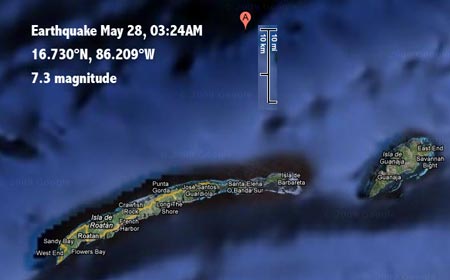« Diving the Folsom Lake parking lot | Main | A greener lake »
May 29, 2009
An earthquake hits Roatan
At 3:24 in the morning, a strong earthquake, measuring 7.3 on the Richter scale, hit Roatan. According to the USGS, the epicenter was at 16.730°N, 86.209°W, less than 20 miles north off the eastern tip of Roatan. The earthquake had a shallow depth of just 10 kilometer, with shallow earthquakes usually creating greater damage. This earthquake apparently happened as the result of movement on the Swan Islands fault, which is a segment of the boundary between the North America and Caribbean plates. The plates there move about an inch a year and cause frequent earthquakes. The last major one caused by friction between the North America and Caribbean plates happened in February of 1976 in Guatemala. That one measured 7.5 on the Richter scale and resulted in almost 25,000 deaths.

Despite the magnitude and proximity, this earthquake appears to have done far less damage. As of May 29, the USGS reported six fatalities, 40 injuries, and 130 buildings damaged or destroyed in northern Honduras, with the earthquake also felt in the entire region.
I read about the earthquake a few hours after it had occurred and worried about how it had affected Roatan itself. The Cocoview resort has a website with two webcams as well as a very active bulletin board. I was relieved when I saw both cameras online, showing no apparent damage to the dock area with the boats nor to the structures on the water in front of the resort.
Apparently, Cocoview had neither lost power nor internet access for any length of time as reports began coming in on the CoCo Chat bulletin board. "Doc" Radaswki reported that everyone on the staff and their families were okay, and that the resort itself was okay as well, except for broken water pipes and major clutter from things falling down. He reported that the home of Jorge, who had been our boat captain the first time we visited Roatan, was badly damaged.
There were also reports from underwater and those sound quite intense. It was reported that the wreck of the Prince Albert had a big buckle and crack in one area, and another new crack running all the way down the ship from top to where it rests in the sand. It was also reported that huge pieces of coral had broken off walls and toppled.
A second report by the same source (user name Habib at CoCo Chat) said that a large number of sponges had simply been sheared off at the base, that there was much damage to Neuman's Wall near the Prince Albert, with pieces broken off the wall and falling to the bottom, exposing edges of long dead coral. It was mentioned again that the Prince Albert had developed large holes, with rust clouds still spewing out. Habib also reported "weird noise we are all hearing underwater...like distant sonic booms reminding me of rolling thunder...you can feel the concusions in the water..."
The underwater reports sound drastic, above water it seems that the area got away with far less damage than could have happened with such a strong earthquake so close. The 6.7 quake that hit Los Angeles in 1994 caused $20 billion in damage.
Doc Radawski reported a couple of days later that two popular dive sites -- Mary's Place and Calvin's Crack -- appear to have survived intact, with sponges sheared off and some new cracks visible on top of the reef, but no visible structural damage or changes.
Dr. Rob Davis of the Whale Shark & Oceanic Research Center on Utila also checked the south east and south west dive sites and found only "minor damage here and there." He reported that the "Labyrinth had a new crack, but overall nothing too dramatic."
Two other divers reported that the damage they saw was depressing, but that for those who don't know every nook and cranny of the sites, there is still a lot of beautiful reef left. They, too, reported that the big barrel sponges do seem to have suffered the worst damage, and that a chunk of Newman's wall closest to the wreck of the Prince Albert came down. They had also gone to the Anka's Place dive site and when they went over the edge of the wall, there was just two hundred feet or so of gray concrete-looking rubble instead of the coral wall and overhang. They also visited Calvin's Crack, and found that other than a couple of big sponges that had come off, the site looked much the same.
Posted by conradb212 at May 29, 2009 3:39 PM








